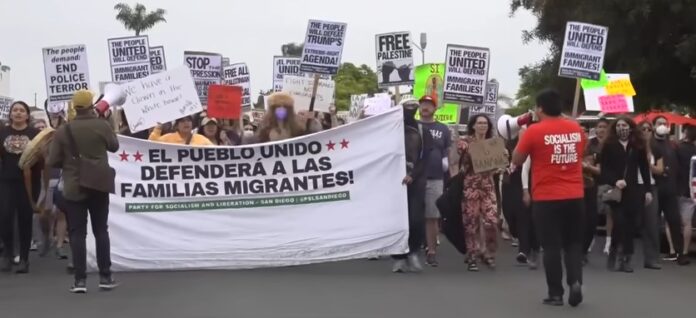Newsman: Sparking protests in L.A. and elsewhere, San Diego’s quaint South Park neighborhood were targeted days before President Donald Trump unleashed federal immigration agents to raid sites spanning from California’s biggest cities to its agricultural heartland. Two popular Italian restaurants were swarmed by Immigration and Customs Enforcement agents on May 30, prompting a remarkable response from neighbors who rallied to the scene and forced a retreat under shouts of “shame.”
Late that afternoon, dozens of ICE agents from the Homeland Security Investigations division entered the side-by-side Buona Forchetta and Enoteca Buona Forchetta restaurants, surrounding them with over a dozen vehicles. Police tape wrapped around government vehicles delineating an off-limits zone where dozens of federal agents congregated.
At Buona Forchetta, known for its award-winning Neapolitan pizza, ICE agents placed all the workers in plastic zip ties. I could see the officers walking around them when I arrived roughly 25 minutes after ICE agents forced their way inside.
One detained worker was being muscled into a van, shackled by handcuffs with ankle restraints. A total of four people were arrested that day — all service workers.
The disruption overwhelmed these already-crowded streets. Diners at nearby restaurants had been enjoying their meals and neighbors were walking their dogs. Children at Albert Einstein Charter Academy prepared to leave the schoolyard before they were directed to a back gate to avoid the commotion.
In that operation, more than 60 federal agents reportedly held dozens of workers for over nine hours, restricting bathroom breaks and offering few snacks. Family members, fellow workers and community members protested outside the facility for hours.
Since late last month, ICE agents have also been arresting migrants appearing at immigration courts. The arrests resemble kidnappings because people are abruptly separated from accompanying family members and attorneys and disappear into elevators.
A crowd had already formed outside of Buona Forchetta by that point. Patrons of nearby establishments, parents with their children in their arms and even dog-walkers were taking turns challenging the masked ICE agents, telling them in colorful language that they weren’t welcome in this neighborhood.
An ICE tactical unit, geared up with helmets and rifles, tossed three loud flashbang grenades at the people who had surrounded their vehicles, intending to disperse them.
Of the four arrested workers, two remained at a for-profit detention center expecting to fight their removal from the United States. One signed a voluntary departure form and is now in Mexico. The fourth, a Colombian national with only a two-week work history at Buona Forchetta, his whereabouts were unknown.
ICE officials justified the raid by pointing to an unsealed warrant that claimed there were 19 instances where employees used fraudulent documents to gain employment. The warrant also alleged the owner of Buona Forchetta was “exploiting these employees by having them work over 12-hour shifts with no breaks,” according to an unidentified November 2020 complaint.
San Diego County’s Office of Labor Standards and Enforcement wage theft judgement dashboard does not contain any record of Buona Forchetta being involved in a labor code dispute.
The confluence of these events in San Diego, alongside actions in other parts of the country where migrants were unlawfully sent to El Salvador, Guantanamo Bay or apprehended without much information about their whereabouts, has caused consternation about the degradation of rights and the heavy-handed approach ICE agents use to detain people.
Trump has now deployed 700 active-duty Marines in addition to federalizing several thousand National Guard troops to ostensibly conduct law enforcement duties in Los Angeles, triggering condemnation by border-based organizations “for the excessive use of force and the militarization of our communities.”

